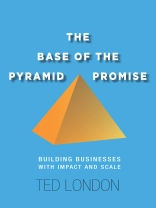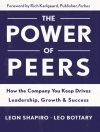As economic growth slows in the developed world, the base of the pyramid (Bo P) represents perhaps the last great, untapped market. Of the world’s 7 billion inhabitants, around 4 billion live in low-income markets in the developing world. These 4 billion people deserve—and, increasingly, are demanding—better lives. At the same time, the business community seeks new opportunities for growth, and the development community is striving to increase its impact. With these forces converging, the potential for mutual value creation is tremendous. This book provides a roadmap for realizing that potential.
Drawing on over 25 years of experience across some eighty countries, Ted London offers concrete guidelines for how to build better enterprises while simultaneously alleviating poverty. He outlines three key components that must be integrated to achieve results: the lived experiences of enterprises to date—both successes and failures; the development of an ecosystem that is conducive to market creation; and the voices of the poor, so that entrants can truly understand what poverty alleviation is about. London provides aspiring market leaders and their stakeholders with the tools and techniques needed to succeed in the unique, opportunity-rich Bo P.
Innehållsförteckning
Contents and Abstracts
Introduction
chapter abstract
This chapter introduces the author and establishes his credentials as a researcher and business practitioner in a number of global settings, including base-of-the-pyramid (Bo P) contexts. It asserts that the focus in Bo P business is, increasingly, ’How can we do this better?’ It promises that this book will provide practically oriented tools, frameworks and guidelines that can help move Bo P enterprises forward, and help them achieve two key goals: an adequate return on investments, and a substantial degree of poverty alleviation. It concludes by describing three foundations on which the book has been constructed: understanding how to build better enterprises, creating value with the Bo P by truly understanding the poverty alleviation opportunity, and establishing an ecosystem of partners to sustain those ventures.
1
Impact Enterprise for the Base of the Pyramid
chapter abstract
Interest in Bo P impact enterprise has been expanding in recent years, both in terms of the literature and the number of enterprises that have been launched. Unfortunately, few such enterprises have achieved sustainability at scale, which is necessary to assure economic viability and alleviate poverty on a large enough scale: here referred to as ’impact enterprises.’ One reason for this is that the learnings of successful impact enterprises have not been widely shared. The chapter differentiates between ’fortune-finding’ and ’fortune-creating, ’ and asserts that the latter strategy is far more effective. Both business leaders and development professionals have good reason to work together to build impact enterprises—but this is far from easy. Obstacles include challenges of value creation, value capture, and the successful bringing-together of two realms that have traditionally eyed each other skeptically. The chapter concludes with a summary of the book’s key prescriptions.
2
Enabling Business Model Innovation
chapter abstract
This chapter opens the discussion of the first of the three foundations of the book described in the preface: understanding how to build better Bo P enterprises. It stresses the importance of innovation, as opposed to an overriding focus on execution, with an emphasis on ’business model R&D—i.e., efforts to invent appropriate business models for specific and demanding contexts. The chapter draws upon a multiyear analysis of 18 Bo P initiatives to explore key design variables that should be considered in Bo P business-model invention, whether alone or in combination. The ’Business Model Innovation (BMI) Framework’ is introduced, which captures the four design variables—resources, metrics, structure, and problem solving—that tend to have an outsized effect. The chapter includes case studies of companies that launched significant Bo P initiatives—Nike, CEMEX, and ’Mondophysic’ (a pseudonym)—to show these variables in action, and to explore which innovation processes succeeded, and why.
3
Building for Scale
chapter abstract
This chapter addresses the challenge of scaling: that is, moving from the pilot phase to an impact enterprise. A framework called the ’C-I-E scaling strategies’ is introduced, focusing on co-creation, innovation, and embedding. Each of these strategies is divided into component parts. Co-creation involves crafting solutions with the BOP and ’finding the positive.’ Innovation involves orchestrating effective experiments and building market opportunities. Embedding involves building collaboration-based competitive advantage and developing social embeddedness. Case studies explore scaling’s challenges: the collaboration between two NGOs (CARE and Peace) and a for-profit (Pioneer Hi-Bred International) to bring new kinds of seeds to India; and ITC’s efforts to transform rural agriculture. Secondary case studies focus on Honey Care Africa’s efforts to scale up Kenya’s honey production, and Movirtu’s initiative to build a sustainable business based on offering a mobile identity that wasn’t tied to a particular mobile device.
4
Mutual Value Creation
chapter abstract
This chapter focuses on the second of the book’s three foundations: creating value with the Bo P by understanding the poverty alleviation opportunity. Alleviating poverty is critical, because it sits at the heart of the Bo P impact enterprise’s value proposition. The more value that enterprise creates for the Bo P, the more value it can capture for itself. Unfortunately, most impact enterprises have a hard time defining their value added, and instead resort to either anecdotes or output measures. A more effective approach begins with an understanding of the multidimensional nature of poverty, which includes economic, capability, and relationship well-being.
5
Creating a Partnership Ecosystem
chapter abstract
This chapter begins the discussion of the book’s third foundation: establishing an ecosystem of partners. These partners are defined as ’scaling facilitators’: i.e., the collaborators who will help the impact enterprise scale up through the use of different implementation models. These collaborating organizations can provide support at the enterprise level (enterprise development) and at the macroeconomic level (market creation). The chapter introduces a tool called the Partnership Ecosystem Framework (PEF), which helps the impact enterprise.
6
Collaborative Interdependence
chapter abstract
This chapter looks at how an ecosystem of scaling-facilitation partners is developed and managed over time. It advocates for the creation of a ’chief ecosystem director’ (CED) position within the impact enterprise—or, at the least, incorporating this role with the existing top management team—to accomplish these important ecosystem-management tasks. It describes the three major challenges faced by the CED—overcoming biases about seeking subsidized support, dealing with internal resistance to partnerships, and responding to cross-organizational tensions—and suggests strategies for dealing with those challenges. A case study of CEMEX’s Patrimonio Hoy initiative illustrates the importance of a CED. The concept of ’collaborative interdependence’, an approach to framing partnership relevant to Bo P impact enterprises, is then explained and discussed, emphasizing the CED’s responsibility for bringing together independent-but-complementary organizations.
7
Making the Promise a Reality
chapter abstract
The closing chapter recapitulates some of the lessons learned in previous chapters, and looks forward at next steps in the evolution of Bo P impact enterprise. The hard-won wisdom of the last decade or so is that Bo P impact enterprise is more about fortune-creating than fortune-finding—which means that the would-be impact enterprise has to innovate, as well as execute. That innovation takes place in a complex context of potential scaling facilitators, who have to be identified, selected, recruited, and managed. Most informed observers agree that the alleviation of poverty along its many dimensions can be enhanced through the creation of impact enterprises. It is certainly not the only solution; NGOs will continue their good work, and governments will do their part. But it has to be part of the solution. We have to fulfill the promise of building Bo P impact enterprises that are sustainable at scale.
Om författaren
Ted London is an internationally-recognized expert on enterprise strategy and poverty alleviation. He is Vice President of the William Davidson Institute and a faculty member at the Ross School of Business, University of Michigan.












